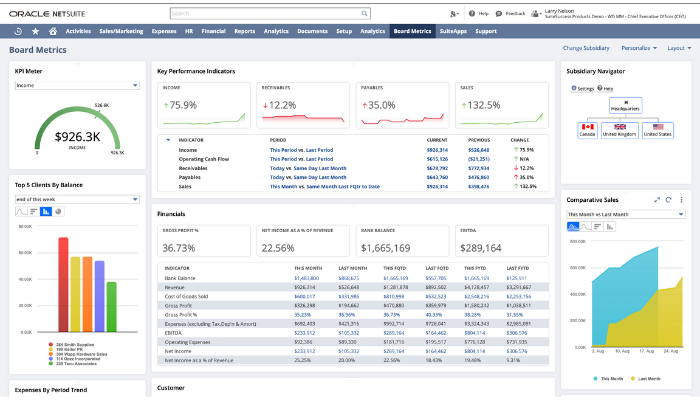Are you concerned about the forthcoming retirement of Sage 1000 and Sage Line 500, and looking for an alternative that can help you propel your business into the future?
Maybe your business is outgrowing its current financial and supply chain software? Or is the increasing list of disparate software tools you use outgrowing your business?
Well did you know that Enterprise Resource Planning (ERP) software lets your team run your business through a single software portal that covers everything, from finances, to stock, to sales, to organisation-wide analytics, and more? And right now, you’d be spoilt for choice for ERP solutions!
So, if you feel like you’re outgrowing your current financial software; you’re sick of juggling separate accounting, CRM, and stock systems; or you’re simply looking to power-up your tech stack, then read on.
The brains here at NoBlue2 have compared two Enterprise Resource Planning (ERP) powerhouses: Sage X3 and Oracle NetSuite. And our recommendation as to which one you should pick is clear cut for some users, but not for others…
But let’s start from the very beginning.
Oracle NetSuite is a fully cloud-based Enterprise Resource Planning (ERP) and business management solution that natively integrates accounts, Customer Relationship Management (CRM), inventory, procurement, and business analytics.
It provides a real-time view of everything going on within a business through intuitive, integrated dashboards so those in charge can always have the right information, in the right format, to make the right decisions.
X3 is a financial and Enterprise Resource Planning (ERP) software solution with particularly robust accounting capabilities, having come from accounting software powerhouse, Sage.
Though it does not include native CRM or Professional Services Automation (PSA) functionality, it does include a handy set of tools for those in manufacturing, warehousing, distribution, food, and chemical spaces.

Oracle NetSuite is a formidable finance and ERP solution for organisations of all sizes looking for robust, cloud-based software to help them run their businesses more efficiently. It includes sales and purchase processing; bill of materials functionality; warehouse and distribution management; business intelligence; CRM; e-commerce functionality; and more. It’s available in 24 languages, with over 50 country localisations.
Sage X3 is a robust mid-market ERP, ideal for mid-sized, potentially international organisations looking for strong financial software functionality, including multiple company accounts, multiple currencies, and wholesale distribution functions, with real-time business analytics and CRM functions available as add-ons.
In terms of “out of the box” functionality, we’d say that NetSuite wins this round. NetSuite features functionality like CRM, PSA, business intelligence, and e-commerce management out of the box, whereas X3 relies on add-ons to achieve the same functionality.
Sage X3 is marketed as a cloud-ready solution, though there is a considerable caveat to add to that claim. Yes, X3 can be deployed on-premise or in the cloud, but all that happens when deploying the software on the cloud is that the same X3 software that would be installed on a local server is installed on your own (or a Sage partner’s) AWS hosting. This could potentially leave you with added running costs and extra cyber-security responsibilities.
In our view, NetSuite wins in this round too. NetSuite is a complete Software-as-a-Service package, hosted within Oracle’s own data centres and kept up to date by Oracle as a part of your licence fee. It’s accessible through any major browser, wherever you are in the world.
However, when you give Sage’s cloud setup the benefit of the doubt, you see that Sage gives you more choice over where your data “lives” (i.e., where it’s hosted). That’s a choice that NetSuite users don’t really get. Whether it’s in your own private cloud or ensconced within your own server behind your own firewall, your sensitive business data is purely under your jurisdiction with Sage – for better or worse! However, of course, servers and hosting can come with their own considerable costs.

NetSuite offers strong native reporting. Due to its massive feature set, NetSuite can naturally provide deep, granular visibility across your entire business. It also provides a huge amount of no-code customisability within reports, so users can tweak things to more easily suit their own and the business’s needs. NetSuite also allows users to explore hypothetical “what if” scenarios and projections.
That’s not to say that Sage X3 doesn’t have robust reporting capabilities, but many of them are only available as extra modules like Sage X3 Data Management and Analytics. These modules need to be purchased from and installed by a third-party provider, so extra cost is usually involved.
Even though Sage X3 includes some very basic report and layout configuration options, adding simple things like custom fields can be remarkably complex for your average user; often requiring coding knowledge to implement. This means that a third-party Sage supplier would need to step in and create or adapt that functionality each time a change was needed.
However, due to NetSuite’s no-code graphical workflow editor, your average user (armed with the right permissions and some very basic training) can customise fields, reports, and dashboards to their heart’s content.

Because Sage X3 is separately installed on each customer’s server (be they cloud or on-premise) there is no central way for Sage to push updates to all users as they become available. In addition, third party customisations can cause compatibility issues with Sage’s updated code, so a third party is usually needed to properly upgrade the software without breaking the user’s custom code and add-ons. This complexity means that Sage X3’s users aren’t all using the latest version, potentially missing out on crucial functionality and security updates.
Yet because NetSuite is completely hosted and managed centrally by Oracle, updates are pushed out to users immediately. This means that all users are automatically going to be using the latest version, benefitting from the latest functionality, interface, and security straight away. NetSuite release planned updates twice a year with lots of helpful documentation. They even provide a sandbox environment so you can get to grips with the new functionality without affecting your existing data. When new NetSuite updates come around, we usually blog about the top new features and host online demos for our customers.
Help and support for Sage products is generally handled by third party Sage partners, but NetSuite users can always contact NetSuite directly. Additionally, NoBlue2 provide support contracts for NetSuite users, so if you’re struggling, no problem is too big or too small for our helpdesk.
Aside from the time and effort spent deciding on technical transformation and internally embedding that change, let’s discuss how quickly you can get started with each solution. ERP software is incredibly in-depth, so it often takes a while to get the data and functionality properly embedded – regardless of which solution you choose.
A typical ERP solution can take anything between 3 and 6 months to implement, dependant on complexity of your business requirements, system integrations and your own internal project team.
Because NetSuite is a true cloud solution it can be provisioned almost immediately, no need to spec and purchase servers, upgrade networks and review client machines giving you a significant head start on your project.
At BrightBridge we also champion a phased approach based on priorities and return on investment, getting businesses up and running as quickly as possible. This phased approach to NetSuite is explained here, and while it focuses on manufacturing, this is only an example, and firms in other sectors will be able to clearly see the benefits.
So, with either solution, be aware that your own mileage is bound to vary!
NetSuite does have a strong multi-sector track record, but there are a couple of specific use cases where X3’s functionality equals NetSuite’s capabilities. One area where the two solutions find themselves neck-and-neck is Wholesale Distribution (WD) functionality. If your business relies on stock, replenishing, retail, picking, and despatch, then know that both solutions provide great support for industries reliant on warehousing and supply chain management.
X3 also challenges NetSuite with its powerful “recipe builder” capability. Here’s where the solution wins hands down over NetSuite, making Sage’s offering a better choice for organisations in food, beverage, chemical, or pharmaceutical industries.
Yet NetSuite’s WD functions can be bolstered by partnering with an implementation partner who has experience in providing ERP solutions to those in the WD and Retail sector – ahem, like us. In fact, we have customised code solutions in areas like carrier integration ready in our back pockets! NetSuite is currently building on its already extensive WD functionality, with new tools like Smart Count and the hotly anticipated 2023.1 Release only a couple of months away. The wholesale and retail sectors are key for NetSuite, so we’d wager the two solutions won’t be neck and neck for long.

Understandably, when it comes to software of any kind, costings can vary depending on the use case, feature set, and number of users required. For ERP implementation projects like these, you can expect to pay an initial implementation fee and a monthly or yearly license fee.
NetSuite’s charging structure is designed to be very simple and transparent. Aside from an initial set up fee from your solution provider, ongoing annual charges consist of three components: the core platform licence, the number of users, and any optional modules the user needs to add. When you choose NoBlue2 as your NetSuite partner, you can also access Oracle Finance to spread the cost of set up over 3 years alongside your monthly subscription.
Sage’s pricing structures are a little more complex, but to be fair, this complexity lets users more easily scale their spend up and down as needed. Aside from any setup fees, Sage X3’s pricing hinges on:
With the upgrades, that will mean that customisations need to be rewritten, integrations re-set, engineers and the project manager will be required to install, test and go through a ‘go live’ process. As you can imagine these fees can be eye wateringly big and almost impossible to budget for.
NetSuite is therefore more straightforward in its approach. Sage’s costing may seem a little more convoluted (and in many ways it is). While it potentially allows X3 users more wiggle room and cost-efficiency, the major downside is that you need to pay to upgrade to the next version. Also, be aware that Sage X3’s licence price is calculated not just per concurrent user but also calculated by role, so roles with less functionality are cheaper. NetSuite, on the other hand, charges a simpler, flat “per user” price.

Our final verdict is… complicated. All in all, we’re drawn to NetSuite due to the sheer volume of off-the-shelf functionality and the vast number of SuiteApps available to augment its already generous functionality. Also consider that NetSuite is totally browser-based, so it’s totally available anywhere, any time as standard – and all users get the latest version at no extra cost
Sage X3 relies on in-house servers and internal IT management; the costs of which add-up, especially when forecasted over a number of years. These costs all need to be considered when weighing up your options. In our view, Sage’s reliance on server installation, third party dependencies, manual upgrades, and its complex costing is a little confusing, so for a company looking to simplify operations, in our view, NetSuite’s the way.
However, X3 does have a good track record in industries such as manufacturing and distribution, and food, drink and chemical industries; so, if this applies to you, then the toss-up between NetSuite and Sage X3 could be a close one. We advise you to start discussions with software specialists for each solution, and to get initial costings and a demo.
NetSuite is particularly great for discrete manufacturers; omnichannel retailers; technology, financial and service providers; and warehouse distribution firms who may feel that they have outgrown Sage solutions or want a solution to support them in business growth.
As 2025 begins, we’re reflecting on a year of transformation and achievements. From pioneering product development to enhancing customer experiences, here are the key highlights of an incredible year for NoBlue2.
The business world is constantly changing, and staying ahead is no easy task. That’s why NetSuite Insights Day 2024, hosted by NoBlue2, was such a pivotal event.
Managing a business though a volatile economy like this is challenging. But there are several strategies you can use to help mitigate risk and ensure the long-term success of your business.
The benefits of Enterprise Resource Planning (ERP) and Customer Relationship Management (CRM) technology (or DRM if we want to relate it to donors) have been widely recognised for non-profits, particularly in helping the sector overcome the many challenges faced in recent years.
There are three main reasons why businesses don’t pay on time and if you deal with them effectively, you can minimise the damage that late payment causes.
Not all companies choose to integrate all their IT systems. It can be due to a lack of internal skills, or not having sufficient time or budget to do it. Here are the issues you can have without system integration.